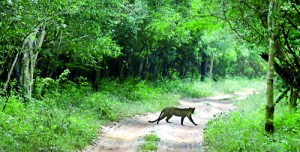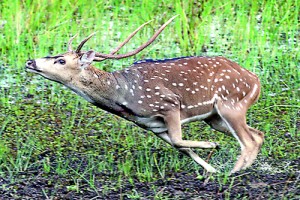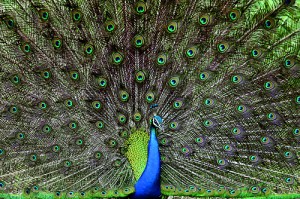Land of the animals
As if in personal greeting, struts the beautiful peacock, vainly displaying the stunning colours of his fan-like tail. It is not a greeting to us though, but the dance of the peacock to attract a partner from among a few peahens moving around, which scrupulously or is it coyly, ignore his amorous overtures.
though, but the dance of the peacock to attract a partner from among a few peahens moving around, which scrupulously or is it coyly, ignore his amorous overtures.
For the eyes of the city-dwellers, however, living in a world of asphalt and concrete, it is a glimpse of what is on “offer” at the Wilpattu National Park, the biggest in the country and not much touched by human invasion. It truly is the land of the animals, where even a slight rustle of leaves in the wind gets magnified.
The omen of the dancing peacock, just beyond the gates of the Wilpattu National Park, bodes well for the Sunday Times teams. Gambolling across our path or lounging in trees bordering the jeep track are also many of our monkey-cousins in the wild.
Wilpattu unveils its secrets, without inhibition, along its sandy tracks, sometimes with a thick canopy overhead, within the environs of its unique villus, at the differently-hued edges of green with splashes of reds which border the thick jungles or in its sparsely-adorned  pitiyas (glades).
pitiyas (glades).
Birds aplenty in their magnificent colours, bright butterflies and insects, we see…………Cormorants, with their snake-like-heads-and necks, diving for fish or sunning themselves with out-stretched wings on a barely-visible tree-stump embedded in the muddy-depths of a villu, the more-regal Adjutant Storks, the Green Bee-eaters, a Changeable Hawk Eagle fixing its focus on us and lots of Malabar Pied Hornbills having sand baths over and over again right in the middle of the track, making those who have come into their territory await their pleasure of moving away. These are a few of the bird life we see at Wilpattu.
The insect-orchestras, including that of the cicadas, always on call and ever-ready to change direction and tone provide muted background music, with a jarring note being struck by the shriek of a peacock.
Lurking or absolutely still like logs, amidst the mud are many crocodiles, big and small while feeding nonchalantly at the edge of a villu, is a huge wild boar with vicious tushes, the swipe of which could very well kill its adversary.
Herds of spotted deer, grazing with their young, would look up startled at the slightest sound from an approaching truck, and with a  flick of their short-tails move at lightning speed, but then stop a little away, heads raised curiously. There are also a few majestically antlered-sambhur among them while one or two barking deer cross the track and barrel into the undergrowth.
flick of their short-tails move at lightning speed, but then stop a little away, heads raised curiously. There are also a few majestically antlered-sambhur among them while one or two barking deer cross the track and barrel into the undergrowth.
A constant accompaniment throughout the day is the jungle fowl, the handsome national bird going hither and thither in search of a delicious morsel, while even when not seen, its ‘spasmodic-coughing’ call can be heard from one direction or another. Not many elephants do we see, only four, but at very close range. Three which seemed like a family feeding at leisure at the edge of a villu and a serene loner knee-deep in water, whom we watched for a long time, taking up a trunkful of grass, swishing away the water, crunching up the preferred parts and then flicking away the roots. For its attraction to water, the frequenters of Wilpattu have named it ‘Diyabariya’.
That first day, however, one of the icons of Wilpattu, the leopard, we don’t see. Are we to be disappointed and not even catch a flash of gold amidst the scrub jungle, of this beautiful predator whose photos on the white sands of Wilpattu’s beaches are legendary. (See box)
The night spent at the Manawila bungalow is an experience of its own. With a few jackals slinking around quite close, night drops suddenly on Wilpattu, after a quick and fascinating sunset over the villu just across. Even the huge geckos which scramble along the walls of the bungalow look other-worldly. Unlike those found in the towns, they are an eerie white.
Absolute isolation, with no service for mobiles, in the middle of the thick jungle but a feeling of serenity and tranquillity– no human voice or rumble of vehicle marring the stillness. The urgent and surprised belling of a deer, as if while on the run, keeps us wondering. Will we see the spotted predator tonight?
We don’t. We see only brightly twinkling stars in an inky blue-black sky, with no clouds obstructing the discernible shapes of the constellations including Orion.
As we leave the comforting embrace of Wilpattu the next morning, to me, the foray into the wilderness has been a personal journey of fulfilment.
Nostalgic it is for me, because Wilpattu is where we roamed so long ago, practically every weekend, as a family, with parents who were connoisseurs of the jungle. This is why Wilpattu has a special place in my heart.
Pix by M.A. Pushpa Kumara
| Spotting the spotted beauty
The safari truckers murmured about sightings of the sleek predator of Wilpattu just near the gate itself, referring in awe to some having even seen a prey being dragged across the track. The proof assailed our nostrils — a strong odour of the mala kuna (stench of the carcass). The first day, however, the leopards seemed to have retreated from the glare and heat of the scorching sun, into the comforting shade of the jungle. The next day we held our breath in anticipation. Not only were we leaving Wilpattu that morning but there had been some rain the night before. No, it’s a leopard, without a care in the world, giving us a casual glance and nonchalantly stretching out and then walking into the undergrowth to our right. Just before, not even a km away, there is another one, relaxing in the bush, very close to the track. Is it bothered – not at all? Turning its head in one direction and then another, in no hurry to leave, this spotted beauty cannot care less that we and several others in a few trucks are gaping at it in wonder. Wilpattu did keep its promise of showing off one of its most valuable assets. |



